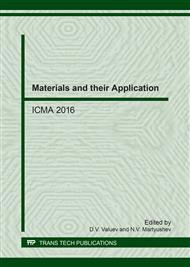p.143
p.147
p.153
p.161
p.166
p.171
p.179
p.183
p.187
Heat-Resistant Porous Composite Based on Ordinary Clay for Thermal Insulation of Hot Surfaces
Abstract:
Compositions of porous compounds (density 300 to 500 kg/m3) for thermal insulation of hot surfaces up to 1300oC were developed. Ordinary clay (at a clinkering temperature of 1150...1200oC), was chosen as a main substance for structure formation. The increasing thermo-resistance fraction of a ceramic matrix composite was obtained via embedding a refractory clay and dinas fillers into compositionб as well as by means of optimizing the relationship «ordinary clay – high aluminous cement», for which the formation of additional amount of mullite phase is observed when first heating of material.
Info:
Periodical:
Pages:
166-170
Citation:
Online since:
June 2017
Authors:
Price:
Сopyright:
© 2017 Trans Tech Publications Ltd. All Rights Reserved
Share:
Citation:


